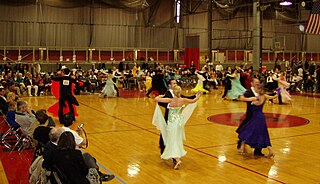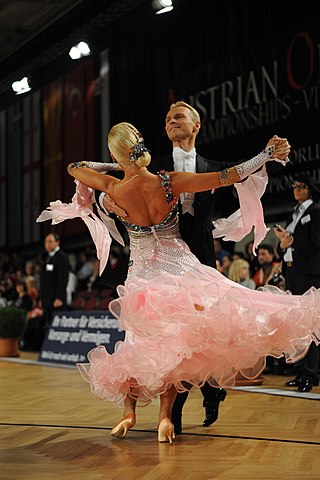External links
- Swedish Dancesport Federation
- Swedish Sports Federation
- International Dance Sport Federation
- World Rock N Roll Confederation
| Summer Olympic Sports |
| |
|---|---|---|
| Winter Olympic Sports |
| |
| Other IOC Recognised Sports |
| |
| Others Sports | ||
Swedish Dancesport Federation (DSF) administers all dancesport in Sweden. The association was formed on February 25, 1968, and is one of 68 different sports federations in Sweden. DSF became a member of the Swedish Sports Confederation (RF) in 1977, which administers all sports in Sweden. Apart from this membership Swedish Dancesport Federation also is a member of the International Dancesport Federation (IDSF) from June 19, 2011, known as the World DanceSport Federation (WDSF) and the World Rock'n'Roll Confederation (WRRC). The office lies in Farsta, Stockholm.
Swedish Dancesport Federation covers approximately 38,500 members in 156 associated danceclubs (2008), from Kiruna in the very north of Sweden to Malmö in the south.
Swedish Dancesport Federation is divided into 9 regions. These regional dancesport federations are more often called districts.
The presidium is selected from the annual general meeting. The presidium comprises the federation's chairman and six general members, and three deputies selected from the annual meeting. In order to support the activities, the organisation is divided in different committees, whose members are elected by the presidium. These committees are; Dance BRR (Bugg and Rock'n'Roll dances), Dance Tendance, Information-PR, Youth, Jurisprudence, District-Central Projects and Line Dance.
Dancesport within the association is divided in three dance categories. Namely Ballroom dancing (Tendance), Swing dances or as called in Sweden Bugg and Rock'n' Roll dances (in short terms just BRR dances) besides Line dance. Ballroom covers five Latin dances (Cha-Cha-Cha, Samba, Rumba, Paso Doble and Jive), and five Standard dances (Slow Waltz, Tango, Slow Foxtrot, Viennese Waltz and Quickstep). BRR dances covers Bugg, Double bugg, Lindy Hop (Jitterbug), Boogie Woogie and Rock'n'Roll dance.
The danceclubs, associated to Swedish Dancesport Federation, arranges each year approximately 75-100 dance competitions around Sweden. In order to see dance competitions one can view the eventcalendar on the Swedish Dancesport Federation's webpage. The dance couples is divided into several age groups (children, youth, junior, main and senior), and in different classes (A, B, C, D, and E), where A is the highest level (elite). On dance competitions in Sweden all ages and a majority of the classes often occur. Common is however, that dance competitions are separate for Line dance, Ballroom dances and BRR-dances. District championships and Swedish championships are arranged annually in all dances, as well as Swedish Championships for danceclubs (teams).
International dance competitions like Nordic championships is also arranged annually between the Nordic countries, beside European championships and World championships in all dancesport styles, where Sweden are represented by the national team in BRR dances and the national team in Tendance. National team in Line dance is not yet appointed. One annually reappeared world ranking competition, Gothenburg International, with top-ranked dance couples participating from all over the world in Ballroom dance and Latin, is also arranged in Sweden.
The Swedish Dancesport Federation administers the following dance styles:

Ballroom dance is a set of European partner dances, which are enjoyed both socially and competitively around the world, mostly because of its performance and entertainment aspects. Ballroom dancing is also widely enjoyed on stage, film, and television.

Swing dance is a group of social dances that developed with the swing style of jazz music in the 1920s–1940s, with the origins of each dance predating the popular "swing era". Hundreds of styles of swing dancing were developed; those that have survived beyond that era include Charleston, Balboa, Lindy Hop, and Collegiate Shag. Today, the best-known of these dances is the Lindy Hop, which originated in Harlem in the early 1930s. While the majority of swing dances began in African-American communities as vernacular African-American dances, some influenced swing-era dances, like Balboa, developed outside of these communities.

The World DanceSport Federation (WDSF), formerly the International DanceSport Federation (IDSF), is the international governing body of DanceSport and Para DanceSport, as recognised by the International Olympic Committee (IOC) and the International Paralympic Committee (IPC).

Dancesport is competitive ballroom dancing, as contrasted to social or exhibition dancing. In the case of Para dancesport, at least one of the dancers is in a wheelchair.
Formation dance is a style of ballroom dancing. It is pattern or shadow team dancing by couples in a formation team. The choreography may be based on a particular dance or a medley of dances. Formation dancing may be done for exhibition or for competition between teams. There is also a type of formation in Bhangra.
This page lists the official World Champions – Professional Latin of the World Dance Council (WDC). The championships are authorized and organized under the auspices of the WDC, and held annually in the last quarter of each year. The competition comprises five dances: rumba, samba, paso doble, cha-cha-cha and jive, as defined in ballroom dancing terms.
World Rock'n'Roll Confederation (WRRC) was registered in 1984, although its history traces to 1974. It is an umbrella organization for national professional and amateur Rock and Roll dancesport federations. Its statute that it "aims at promoting the physical training of its members by means of sporting activities in the form of Rock'n'Roll dance tournaments, including the acrobatic variations as well as Rock'n'Roll and Boogie Woogie, Lindy Hop, Formation and alternative styles in line with the rules and sporting presentations". The registered office is in Neuhausen am Rheinfall, canton of Schaffhausen, Switzerland.

Boogie-woogie dance is a European variation of swing dance often done competitively that developed in the 1940s. Although its name derives from the boogie-woogie genre of music, it is most often danced to rock music. The form is cited in Madonna's hit single "Music"

Waltz is one of the five dances in the Standard category of the International Style ballroom dances. It was previously referred to as slow waltz or English waltz.
Canada DanceSport (CDS) is the governing body for Dancesport in Canada, with disciplines including competitive ballroom dancing and breakdancing. It has been a member of the World DanceSport Federation since 1979 and is recognized by the Canadian Olympic Committee. CDS sanctions the annual Canadian Closed Championships.

Wheelchair dancesport, also known as Para dance sport, is a form of competitive dancesport where at least one of the dancers is in a wheelchair. The sport corporates the rules of the World DanceSport Federation (WDSF).
Bugg is a common dance style in Sweden and is very popular on the dancefloors, when dansbands play. Bugg is a four-step dance and performed at different paces. Bugg is a partner dance and follows certain basic rules, but is essentially improvised, with the woman following the man's lead. Acrobatic moves are not allowed on national or international dancecompetitions. Swedish Bugg belongs to the swing dance family and closely resembles Modern Jive.
XS Latin is a formation dance team based in Cambridge, UK. It is ranked 1st in the UK and 11th in the World as a Latin Formation Team.

The English Amateur Dancesport Association (EADA) Ltd is a volunteer-led organisation which represents the interests of Amateur Dancers within England. EADA provides support and training for Amateur dancers and acts as the voice of English Amateur dancers amongst other dance organisations both in the UK and overseas. EADA also aims to get the younger audience involved and on the dance floor. EADA hopes to increase the profile of dancesport.
The International Latin American Dance Championships were created after the Second World War in England by Elsa Wells, and are now organised by Dance News special events. The current full title is the Elsa Wells International Dance Championships, and includes all categories in Standard and Latin American ballroom dance.
USA Dance, formerly the United States Amateur Ballroom Dance Association (USABDA), is a national governing body for DanceSport in the United States. It is recognized as such by the World DanceSport Federation (WDSF), the U.S. Olympic Committee (USOC), and the Amateur Sports Act of the United States Congress. In addition to promoting ballroom dancing as a recreational activity, USA Dance also promotes DanceSport nationally and internationally.
"Vivat Russia!" International Open DanceSport Tournament is a dancesport tournament held on annual basis in Krasnodar region. Starting from 2007 the tournament is recognized as an international one being held in Adler, from 2009 on the tournament has been held in Sochi. The contest consists of two syllabi: Standard and Latin. Dancers that chose the first syllabus must base their routines on Waltz, Tango, Viennese Waltz, Slow Foxtrot and Quickstep. Dancers that chose the Latina syllabus must base their routines on such dances as Latina, Samba, Cha-Cha-Cha, Rumba, Paso Doble and Jive. "Vivat Russia!" is a traditional tournament of the World DanceSport Federation (WDSF). Each participant of the tournament receives rating points and takes his or her position in the world ratings based on the rank achieved. International status is the highest status available, thus couples competing at "Vivat Russia!" Tournament may potentially receive maximum possible number of points.
Double bugg is a Swedish swing dance.

DanceSport South Africa (DanceSport SA) (DSSA), formerly the Federation of Dance Sport South Africa (FEDANSA), is the governing body for dancesport and related dance styles in South Africa. It is an full member of the world governing body World DanceSport Federation (WDSF) and recognised by SASCOC. DanceSport SA is the sole custodian and controlling body of organised dancesport in South Africa.

The All India DanceSport Federation (AIDSF) is the national sports federation for dancesport in India.